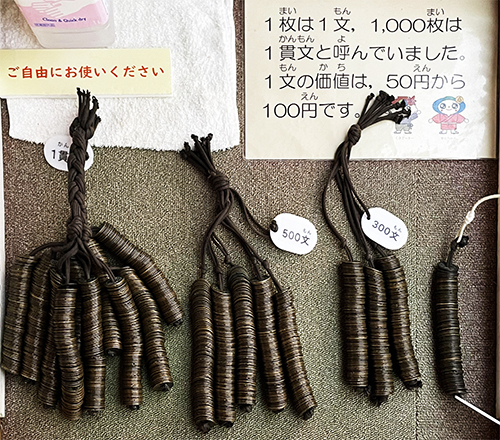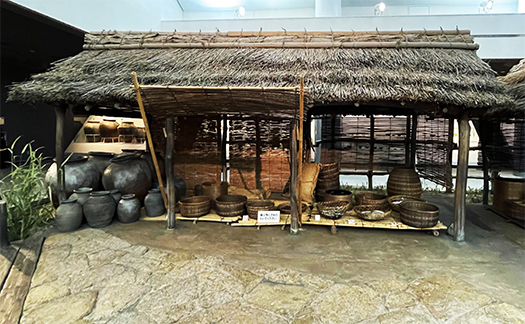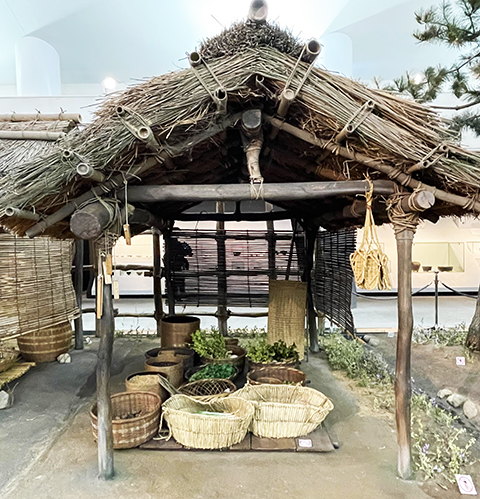


この草戸千軒の都市の様子は、約600年前の頃の状況を復元再生させた展示。室町時代中期から後期に掛けての町と時代の庶民の日常が活写されている。
日本史では古代の公地公民制という「タテマエ」が現実にはほとんど機能せず、土地の「私有制」といえる「荘園」体制が全国で一般化していった時代。この草戸千軒にほど近い「安芸国沼田荘」は、開発領主の沼田氏が中央の貴族に寄進して成立した荘園だった。それが中央での政変などによる有為転変の結果、京都の「蓮華王院」が領主になって、のちに戦国武将になっていく「小早川氏」が武権を担う地頭になっている。
こうした荘園公領制は日本の中世における荘園および公領を土台とした重層的土地支配構造のこと。現地のムラの農民にして見ると領主による搾取に苦しめられた時代だけれど、同時に生産力の増大に伴って領主層に対して年貢の軽減要求など自立的な姿勢が盛り上がっていった。
こういう時代背景の中で、各荘園農民から発生した「余剰生産物」を交易する一種の「解放区」のようにして千軒と言われるような都市機能が成熟していった。そうした「市」では中国貨幣などが決済手段として活用された。現代に繋がってくる「市民社会」的な萌芽形態が見られ始めたということだろう。
歴史の授業を受けながら、こういう時代に差し掛かってくると、ワクワク感が学ぶ側にも募っていた(笑)。


貨幣経済化という身近感。上の貨幣は1貫文が5-10万円程度。捉えやすくすれば現代の10万円で、その半分で5万円、3万円といった換算になるだろうか。
船着き場と「市」場は隣接していて、荷揚げした商品の一時置き場所には簡易な差し掛け小屋。そして市場には草葺き小屋。こちらは自然木利用の掘立柱建築で壁は造作されていない。物品については出土遺物を考慮している。
大きな壷が置かれているが、生活の第1条件は水の確保であり、井戸で水を汲むのにも各戸での貯水が絶対不可欠。最大の必需品だったことは自明の理。
一般商品として活魚・干物・貝類・海草・塩・山鳥。さらに米・豆類・野菜・筵などが販売されていた。油や土器(かわらけ)などは担いで売り歩く「振り売り」などもあったとされる。
それこそ「需要と供給」という経済原則、人間の営みのそのままが正直に全面展開している。
どうもわたしは家系的にもこういう現場感覚が肌にしっくりくる部分があって、現代生活でもたくさんの買い物客が集まる店舗などではちょっと「血が騒ぐ」(笑)。原始から古代と歴史を見てきて、ようやく「オレたちの時代」という雰囲気に引きずり込まれてしまうのですね。
English version ⬇
Logistics and stores in the Seto Inland Sea, 1400s, Kusado-Senken 2023 revisited-4.
A jar is equivalent to a water bill in modern times. It is a basic tool for daily life. I am delusional and think that 10 years’ worth of water bill including shipping cost would be reasonable. I am full of delusions.
This exhibit of the city of Kusado-Senken restores and recreates the situation as it was about 600 years ago. It vividly depicts the daily lives of the common people of the town and period from the mid to late Muromachi period.
This was a time in Japanese history when the ancient “tatemae” system of public lands and civic rights hardly functioned in reality, and the “shoen” system of “private ownership” of land became common throughout the country. The “Aki Province Numata Manor” near Kusado-Senken was a manor established by the Numata clan, a development lord, who donated the land to the central aristocracy. As a result of political changes in the central government, the “Rengeoin” of Kyoto became the lord, and the “Kobayakawa,” who later became a military commander in the Warring States period, was made the head of the manor.
The manor-governing system in medieval Japan was a multilayered land control structure based on manors and fiefdoms. The local peasants suffered from exploitation by their lords, but at the same time, as their productive capacity increased, they actively demanded a reduction in annual tribute from the lords.
Against this backdrop, a city functioned as a kind of “liberated zone” for trading the “surplus products” generated by the peasants of each manor, and a city of 1,000 houses was established. In such “cities,” Chinese coins were used as a means of payment. This may mean that the budding form of “civil society,” which is connected to the present day, was beginning to be seen in these “cities.
While taking the history class, I felt a sense of excitement as the class approached this period (laugh).
A familiar feeling of monetary economization. The coinage above is about 50,000-100,000 yen per kanbun. To make it easier to grasp, it would be 100,000 yen today, and half of that would be converted to 50,000 yen, 30,000 yen, and so on.
The landing place and the “market” are adjacent to each other, and a simple hut is used as a temporary storage place for unloaded goods. The market place is a thatched hut. This hut is a dug-out pillar structure made of natural wood with no walls. The goods are based on excavated artifacts.
A large jar is placed here. The first requirement for life was to secure water, and it was absolutely essential to store water in each house, even to fetch water from a well. It is self-evident that this was the greatest necessity. General commodities included live fish, dried fish, shellfish, seaweed, salt, and mountain birds. In addition, rice, beans, vegetables, and mats were sold. Oil and earthenware (kawarake) were sold by “swing peddlers,” who carried them around on their shoulders.
The economic principle of “supply and demand,” or human activity as it is, is honestly and fully developed.
I have a family history of feeling this way, and I get a little “excited” when I am in a store where many shoppers gather (laugh). (Laughs.) Having seen history from the primitive to the ancient times, I am finally drawn into the atmosphere of “our time.
Posted on 12月 16th, 2023 by 三木 奎吾
Filed under: 住宅マーケティング, 日本社会・文化研究







コメントを投稿
「※誹謗中傷や、悪意のある書き込み、営利目的などのコメントを防ぐために、投稿された全てのコメントは一時的に保留されますのでご了承ください。」
You must be logged in to post a comment.